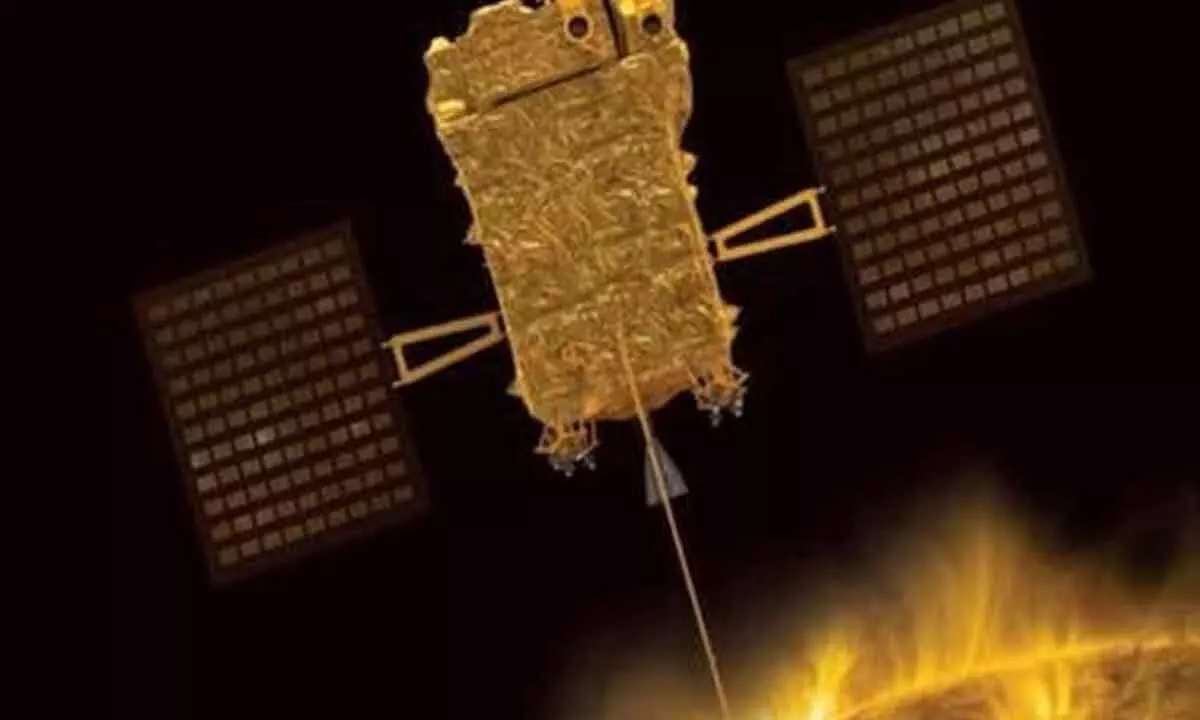Live
- MLA Yennam Leads in Vidya Nidhi Donations, Envisions Mahabubnagar as an Education Hub
- Session on Narrative Building Highlights India’s Changing Global Stance- Sood
- Garena Free Fire MAX Redeem Codes (11 January 2025): Unlock Free Diamonds, Skins, and More
- Mangalore lit fest Policy Reforms and Outdated Laws needed-Sanjeev Sanyal
- Makara -Mahotsav (Sankranti Sambaralu) and National youth day celebrations at Sphoorthy Engineering college
- ASHA Workers Secure Improved Pay and Benefits
- Police Arrest “Digital Arrest” Mastermind
- Puri Backs Energy Security Summit in Mangaluru, Calls for Wider Public Engagement
- Daku Maharaj Trailer Released: Balakrishna's Intense Performance as a Master of Killing Gives Goosebumps
- India’s Energy Sector Poised for Growth Amid Challenges: Hardeep Singh Puri
Just In

Aditya-L1 blast off at 11.50 am
Bengaluru: After the successful Chandrayaan-3 mission to the Moon, ISRO announced on Monday that India's first solar mission Aditya-L1 to study the Sun will be launched on September 2 at 11.50 am from Sriharikota spaceport.
Aditya-L1 spacecraft is designed to provide remote observations of the solar corona and in-situ observations of the solar wind at L1 (Sun-Earth Lagrange point), which is about 1.5 million km from the Earth. Lagrange Points are positions in space where the gravitational forces of the Sun and the Earth produce enhanced regions of attraction and repulsion. These can be used by spacecraft to reduce fuel consumption needed to remain in position, according to NASA. Lagrange points are named in honor of Italian-French mathematician Josephy-Louis Lagrange.
The Bengaluru-headquartered space agency said in a social media post that the spacecraft -- the first space-based Indian observatory to study the Sun -- would be launched using a PSLV-C57 rocket.
The Aditya-L1 mission, aimed at studying the Sun from an orbit around the L1, would carry seven payloads to observe the photosphere, chromosphere and the corona -- the outermost layers of the Sun -- in different wavebands.
Aditya-L1 is a fully indigenous effort with the participation of national institutions, an ISRO official said.
The Bengaluru-based Indian Institute of Astrophysics (IIA) is the lead institute for the development of Visible Emission Line Coronagraph (VELC) payload while Inter-University Centre for Astronomy and Astrophysics, Pune, has developed the Solar Ultraviolet Imaging Telescope (SUIT) payload for the mission. According to ISRO, VELC aims to collect data for solving how the temperature of the corona can reach about a million degrees while the Sun's surface itself stays just over 6000 degrees Centigrade.
Aditya-L1 can provide observations on the corona, and on the solar chromosphere using the UV payload and on the flares using the X-ray payloads. The particle detectors and the magnetometer payload can provide information on charged particles and the magnetic field reaching the halo orbit around L1.
The satellite, developed by U R Rao Satellite Centre here, arrived at ISRO's spaceport of Sriharikota in Andhra Pradesh, earlier this month. It is planned to be placed in a halo orbit around the L1 point of the Sun-Earth system. A satellite placed in the halo orbit around the L1 point has the major advantage of continuously viewing the Sun without any planets obstructing the view or causing eclipses, ISRO noted.
"This will provide a greater advantage of observing the solar activities and its effect on space weather in real time," it said. Using the special vantage point L1, four payloads would directly view the Sun and the remaining three payloads are expected to carry out in-situ studies of particles and fields at the L1 point, thus providing important scientific studies of the propagatory effect of solar dynamics in the interplanetary medium. "The SUITs of Aditya L1 payloads are expected to provide the most crucial information to understand the problem of coronal heating, coronal mass ejection (CME), pre-flare and flare activities and their characteristics, dynamics of space weather, propagation of particle and fields, etc," ISRO said.
The major science objectives of the Aditya-L1 mission are: study of solar upper atmospheric (chromosphere and corona) dynamics; study of chromospheric and coronal heating, physics of the partially ionised plasma, initiation of the coronal mass ejections, and flares; observe the in-situ particle and plasma environment providing data for the study of particle dynamics from the Sun; and physics of solar corona and its heating mechanism.

© 2025 Hyderabad Media House Limited/The Hans India. All rights reserved. Powered by hocalwire.com







